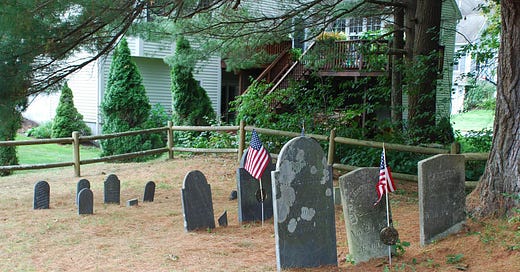Welcome to History Buzz! We hope you enjoy the new format. We love to hear from you, so please leave comments or send an email to HistoryBuzz@andoverhistoryandculture.org.
Nestled within a development and hidden behind brush sits a small family cemetery known as the Woodbridge-Jenkins Cemetery. The drab slate gravestones sit in stark contrast to the large, brightly painted homes that surround it.
So why is it here?
One clue comes from a house two doors down on Douglass Lane. It doesn’t look quite like the rest, and that’s because it’s much older.
This is the William Jenkins House. Built in 1765, it sits on land granted to the Osgood family by the King of England (probably Charles I). Samuel Jenkins purchased the estate c.1758, but, interestingly, the first burial took place five years prior.1
In September 1753, three children of Samuel and wife Rebecca died on three consecutive days. Disease is the likely culprit but the details are unknown.2 Their deaths led to the establishment of a cemetery on what would soon become their homestead.
When you view the Jenkins House from Douglass Lane, you can only see the side of the building. The house faces south towards the cemetery and Harold Parker Road. The cemetery was just a couple hundred feet from their front door.
The first Woodbridge to be buried was Martha in 1805.3 The Woodbridge family owned the Jenkins’ property before 1758 and therefore may have made sense to bury her there.4
In the 19th century the Jenkins House was home to William Jenkins, the house’s namesake and arguably its most famous resident.
He and his wife Mary were abolitionists and their house was a station on the Underground Railroad. Between the 1830s and 1863, fugitive slaves from the South found temporary refuge at their house as they made their way to freedom in Canada. William was so committed to the issue that he left the South Church, which didn’t support the abolition, and constructed hiding spots for his guests.5
One hiding spot was a hollowed-out rock on the property.6 Another was beneath the attic floorboards by the chimney.7
The Jenkins House was a significant stop on the route north, and its proximity to the schools on Andover Hill lent itself to visits by Harriet Beecher Stowe, Frederick Douglas, William Lloyd Garrison, and the Hutchinson Family Singers, an 1840s pop group.
The homestead is also known as the site of a soapstone quarry. Among other things it provided the stone for the graves in the family cemetery and other town burial grounds.8
Most of the burials took place in the early to mid-1800s, including two veterans of the Revolutionary War, Benjamin Jenkins and Benjamin Woodbridge. Jenkins, son of the previously mentioned Samuel, joined the Massachusetts Militia after the war and rose to the rank of Lieutenant Colonel in 1810.9
William Jenkins the abolitionist was the last to be buried in the cemetery in 1878. He lived to see the end of slavery in America, but in retrospect African Americans were still a long way from equality.
Burials are usually permanent, but not for the Jenkins family. In 1882, Jenkins descendants exhumed their ancestors and reinterred most of them in Spring Grove Cemetery, established in 1871. That left just six members of the Woodbridge family and three Jenkins children on the homestead.
From that point on the Woodbridge-Jenkins Cemetery received relatively little attention. In 1930, historian Lenora White McQuesten conducted a study on the people buried there. In 1996, a developer purchased the estate and subdivided it into the Mortimer and Douglass Lanes we see today. Part of the development project included restoring the Jenkins House and cemetery. A group of archaeologists from the University of Massachusetts confirmed the number of burials that took place: 17.
The cemetery got more attention in 2003 when Eagle Scout projects did more restoration work. Jeffrey Page constructed a bridge in 2014 to span a small wetland and provide public access to the grounds.10
Further reading:
Town of Andover Report on the Woodbridge-Jenkins Cemetery
A list of cemeteries in Andover with brief descriptions
Andover Townsman - Jeffrey Page's Eagle Scout project
More information on the Underground Railroad and the William Jenkins House
Nancy J. Stack, Juliet Haines Mofford, and James S. Batchelder, “8 Douglass LN,” Andover Historic Preservation, Andover Preservation Committee, last modified September 13, 2014, https://preservation.mhl.org/8%20Douglass%20LN.
Nancy J. Stack, Juliet Haines Mofford, and James S. Batchelder, “4 Douglass LN,” Andover Historic Preservation, Andover Preservation Committee, last modified February 21, 2016, https://preservation.mhl.org/4-douglass-ln.
Ibid.
Stack, et. al., “8 Douglass LN.”
Wilbur H. Siebert, “The Underground Railroad in Massachusetts,” Proceedings of the American Antiquarian Society, April 1935, 51, https://www.americanantiquarian.org/proceedings/44806916.pdf.
Stack, et. al., “8 Douglass LN.”
Bessie Goldsmith, Historic Houses in Andover, Massachusetts, Compiled for the Tercentenary (Andover: n.p., 1946), http://www.pa59ers.com/library/Historic/houses.html.
Stack, et. al., “8 Douglass LN.”
Lenora White McQuesten, Farm and Neighborhood Cemeteries of Andover and North Andover, Mass., Including Stone Inscriptions (Andover: n.p., 1930), https://archive.org/details/farmneighborhood00mcqu.
Stack, et. al., “4 Douglass LN.”







Hi Jane, did you see the report I wrote for Jeffrey when he was doing his bridge project? I determined who was actually there, who had been moved, and to where. It should be in the Woodbridge-Jenkins Cemetery file. I gave this information to various sites, like the library, and even to Spring Grove to update their records, but alas, they haven't. Or, I can send you a copy!